I like having the largest battery and inverter capacity just like the rest of us. But, what if you could have a high capacity AC inverter in a small size package and maintain good battery capacity. A smaller size, high power, fully featured unit would appeal to a large number of users such as: Home emergency back up, campers, Van Dwellers, recreationalists, tradesmen and all around general users. Does such a unit exist?
Wait no longer, the EB55 is here!
Below are the EB55 specs:
Battery Capacity:32,000mAh 22.4V/537Wh
Battery Cell Type:LiFePO4 (2500+ Full Life Cycles)
Dimensions:10.947.877.79 in. / 278200198 mm
Weight:16.5lbs / 7.5kg
ECO Mode:Yes, Switch On/Off Optional
4*AC Outputs:100-120V, 700W (1400W Surge) , 50Hz / 60Hz, Pure Sine Wave
1USB Type-C Outputs:5V, 3A / 9V, 3A /12V, 3A / 15V, 3A / 20V, 3A / 20V, 5A (100W Max)
1Car Port:DC Regulated 12V, 10A
4USB-A Outputs:5V, 3A
**2DC Outputs**:12V, 10A, 5.5mm x 2.1mm
1*Wireless Charging Pad:5W / 7.5W / 10W / 15W
DC Input:12V~28V, 8A (200W Max), 7.9mm x 0.9mm
LED Lighting:Full Bright / Half Bright / SOS Flash Mode
I received my EB55 yesterday and went right to work running it though the paces to see if it lived up to expectations. The shipment arrived in a very sturdy double box. The outside box is very thick and durable to protect the inner retail packaging. All items arrived in great condition with no damage. The overall unit appears to be built with
**high quality materials **and is well made. The size of the EB55 is somewhat larger than a Jackery 300 and slightly smaller than an Ecoflow River Max. (See comparative pics)
Inside the package are: EB55 main unit, 200 watt AC charger, Car Charger cord, MC4 to XT60 solar input cable, operators manual and warranty information.
After turning the EB55 on it appeared to have been shipped at 60% battery capacity and should be fully charged before use. The display is a color display that indicates the remaining battery capacity with a rudimentary 5 segment bar divided 20% segments. Also displayed are the incoming and outgoing watts in 1% increments. Other warning and operational symbols are also displayed at times around the perimeter of the display. The display will shut off after 30 seconds of no button pressing which is annoying to the extreme and completely unnecessary for power consumption.
An area flood light is provided on the rear of the EB55 which is both very usable and sufficiently bright to use in an emergency and while camping. Great feature.
The EB 55 incorporates separate operation buttons for each functional output type which is a big advantage when is comes to idle overhead power consumption. The following functions each have their own ON / OFF button and can be used together or separately to minimize idle power draw when not being used. DC 12 volt Power Output Sockets / USB DC Outputs / AC Inverter, The buttons themselves are poorly lit and difficult to determine if they are on or off when outdoors.
Regulated 12 volt DC sockets are included. There is one “Car Socket” and two 5521 sockets. The tested output was 13.38 volts and was maintained all the way to 0% battery capacity indicated. The capacity is listed at 10 amps for each socket type and the 10 amps is total capacity of the three sockets in any combination of use. 10 amps capacity for the 5521 sockets is an advantage and unusual for this type of unit.
Charging the EB55 can be accomplished by a variety of ways:
Two charging input ports are located on the EB55. One AC charger input which is an 8mm female connector and accepts an input range of 25-28 VDC at a 10 amp maximum rate. The second port is for solar charging, is an XT60 connection and accepts and input range of 12-28 VDC with an 8 amp maximum rate.
AC charger (supplied)……The included AC charger charges at a max rate of 208 watts. The charger has a built in fan that runs all the time the charger is plugged into an AC outlet even if not charging. A second AC charger may be purchased that can connect to the Solar input XT port but would require an 8mm female to XT60 converter to operate. This would double the AC charging input to a little over 400 watts for a less than 2 hour charge time.
Car Charging (cable supplied)……The car charging specs are 98 watts at 12 volts or 196 watts at 24 volts. In my testing I was able to achieve a maximum of 79 watt charge rate at 14 volts. The charge rate varied from 20 watts at 12 volts to 88 at 15 volts. I would expect to see a maximum of 74 watts incoming charge rate at an average 13.5 volts reaching the EB55 through the car charge cable. I did test car charging at 25 volts and received 199 watts of charge rate. If car charging was a primary need, I would suggest using a 12 volt to 24 volt step up converter connected directly to the vehicle to get the full benefit of a 200 watt car charge.
PV / Solar Charging (MC4 to XT60 cable supplied)……I used a pair of Aiper 160 watt panels connected in parallel in full sun and received 156 watts at 7.8 amps maximum. I was over paneled and at no time did I ever see more than 156 watts out of the potential 320 watts of solar panel capacity. I then tried a pair of Acopower 120 watt panels connected in parallel during the same conditions and received the same 156 watt maximum watt rate at 7.7 amps.
One major issue that I had while charging with solar and using more than one panel was when any clouds or haze occurred to drop the wattage, the return to full sun conditions did not result in maximum charge of 150+ watts again. I would consistently return to the EB55 and find that it was receiving only 119 watts no matter the sun conditions. IF I DISCONNECTED THE CHARGING CABLE AND RECONNECTED, THE INPUTS WATTS WOULD RETURN TO THE MAX 150 WATT RANGE RATE. With this in mind, I would either recommend using the single Bluetti 200 watt panel of a single 120 watt aftermarket panel. Adding additional panels will not increase the charge rate above 119 watts regardless of the available watts after a shading event. I have seen this same issue on a competitor of orange colored products.
Bottom line, even thought the specs state you have a 200 watt solar input rate, you will only see around 120 max in the real world (156 until a shading event occurs) even with a pair of panels. Keep this in mind for your specific use case.
fK9hZRIhAS5Hanoj2SZpkDQi.jpeg)
Dual Method Charging……You can connect both a solar input cable and an AC charger input cable at the same time. The stated spec is that you can receive a 400 watt maximum charge rate utilizing this method. Since you will be unable to receive the 200 watt maximum solar input rate, you will also be unable to achieve a 400 watt dual charging method input rate. Expect around 320 watts input rather than the 400 and you will not be disappointed.
Pass Through Charging:….Of course the EB55 has the ability to charge and discharge simultaneously. You can be connected to a solar panel and produce AC or DC power at the same time.
Battery Capacity Test….I took the EB55 into my not too secret laboratory to see just how many watt hours I could get out of the battery which is rated at 537 watt hours. I utilized my laboratory grade Samsung 55” LCD TV to display the first three episodes of “Yellowstone” while consuming an average of around 155 watts. I was able to use 502 watt hours for a whopping 95% efficiency rate. This is the highest efficiency rate I have seen and is outstanding. Great class leading job Bluetti!!
AC Inverter:……When producing AC power, the EB55 generated around 113 volts with no load which is somewhat low. I was seeing a low of 112.8 under full load. I did not have any issue with the voltage in this range during operation of a variety of items, but I would like to see the voltage somewhat higher.
The **AC inverter on the small EB55 is a beast **and its best feature. I was able to run anything up to just under 800 watts long term without issue. 800 to 825 watts will run a few minutes and anything over 825 watts will trip the overload. This is great performance from such a small unit. I successfully ran my full size side by side refrigerator and also a 5,000 watt analog control window air conditioner which consumed 785 watts on startup and 372 watts while running. The inverter in this unit is class leading and performs excellently.
Cooling Fan:…… Anyone that has concerns that the EB55 cooling fan is not up to the task of sufficient cooling capacity will not be disappointed. The fan runs during most charging operations. The fan is powerful, single speed, fairly loud and gives the impression it is capably eliminating heat from the unit. During AC or DC output operation, the fan is thermostatically controlled and is off most times under 300 watts of output load. During my hours of watching the Yellowstone series while testing battery capacity the fan only came on during the last couple of minutes of battery exhaustion. You can expect silent AC inverter and DC operation with mild loads unless the thermostatically controlled temp. limit is reached.
During charging from any method, the fan runs and runs high volume and loud. As an added bonus the supplied AC charging brick will be outputting its own fan noise as an unwelcome musical duet. Charging is best done away from the user. During mild AC and DC operation, the fan will not come on unless a temperature threshold is reached.
**Likes: **
Size of the EB55 is just about perfect. Easy to carry and stackable with the folding handle. The materials and construction are first rate.
AC Inverter Capacity is class leading and able to power a wide variety of items that no other unit this size can handle.
**Usable battery Capacity **is outstanding at 95%.
Area Light is a welcome addition and very usable.
Perfect unit for DC compressor fridge operation. The low overhead, solar input capability and battery efficiency make this a great choice for operation of DC compressor fridges in vehicles.
Opportunities for improvement:
**AC charging brick **is bulky, noisy and would much better being replaced by an on board charging system similar to a competitor. No charging brick is a desirable feature.
**Fan Noise: ** The fan while being powerful and capable seems to run at times when not needed (charging) and should be strictly thermostatically controlled and variable speed. During charging with the AC power brick not only is the EB55 fan running full speed, but also the power brick fan and even a second power brick fan if using dual power bricks. The overall fan noise means that during charging, the unit is better placed away from the user.
User Interface: is too basic and not competitive. The remaining battery capacity bar segments need to be replaced with a percent remaining number and include time remaining for battery exhaustion and to fully charge. While usable as is, there are better displays on competitive units. Having the display time out and go off within 30 seconds or less is aggravating and highly annoying when using the EB55. 5 minute time out would not excessively use power and be an improvement. The operation buttons are poorly lit and not recesses which makes it difficult to see if they are on outside and can accidentally be turned off during handling which is an issue when wanting continuous power. Buttons needs to be recessed and better lit up with a stronger click on and off.
App Control: It ain’t there. App control is more and more common and would be a welcome addition to this product line. Several of the opportunities for improvement above could be selectable and solve those issues.
Conclusion:
I like the EB55 and it is class leading in several areas. The power output from the inverter and excellent battery performance are outstanding. This unit is a perfect fit for someone looking for a compact size, light weight SoGen that has performance well above it’s size would suggest.


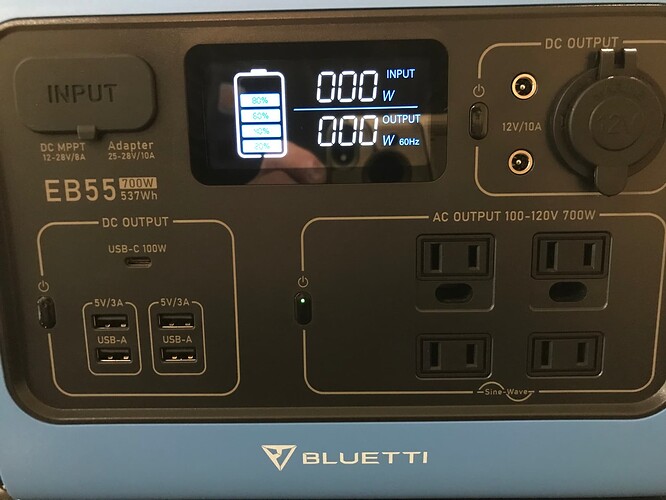
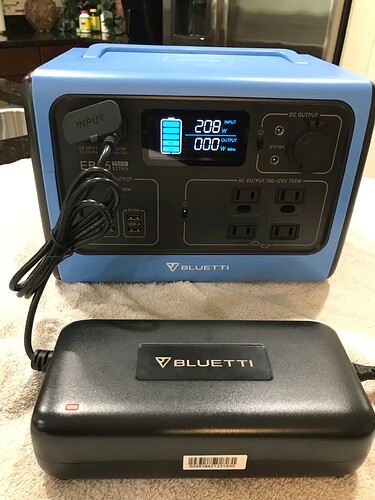
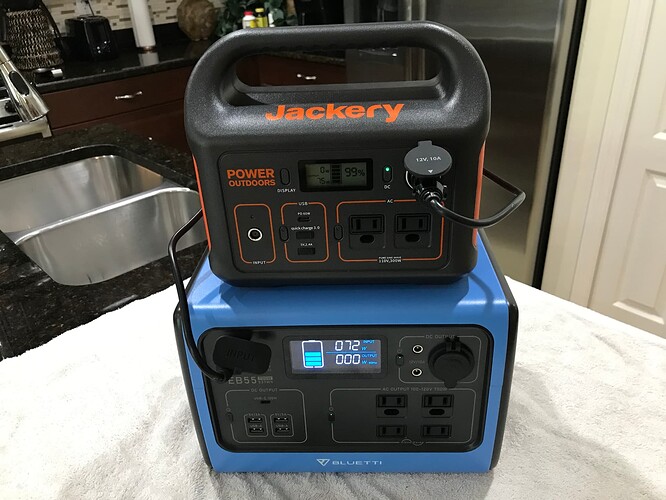
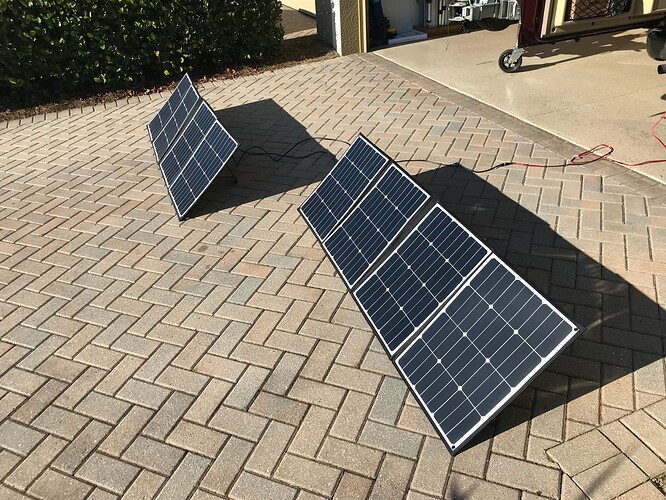
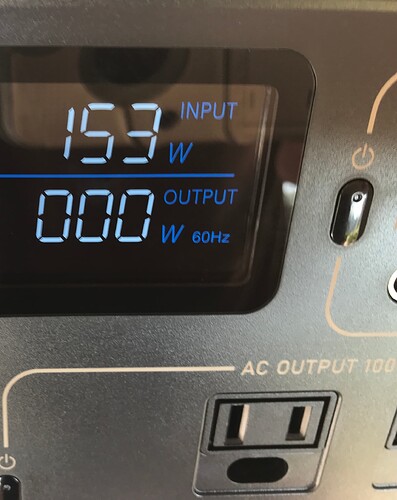
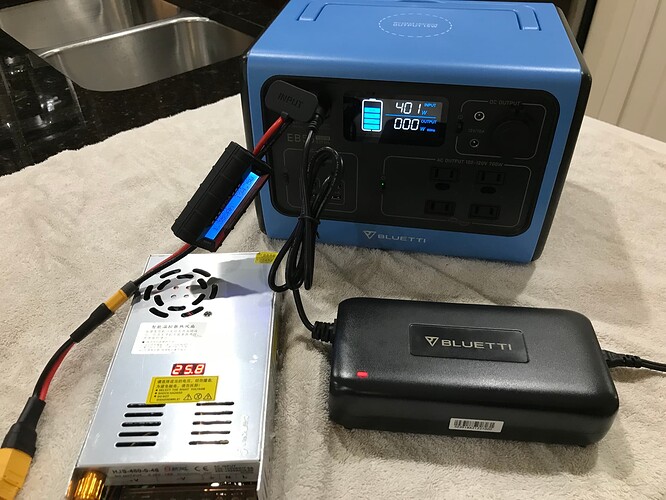

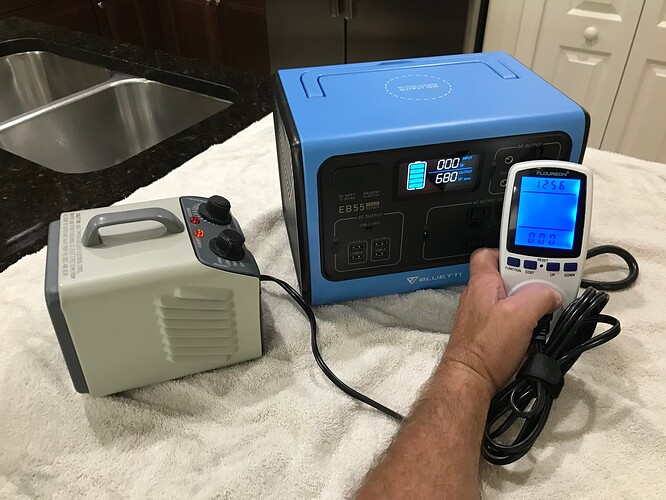
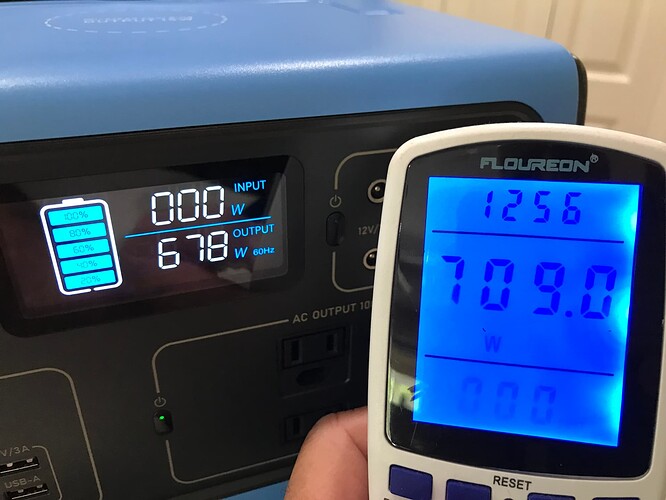

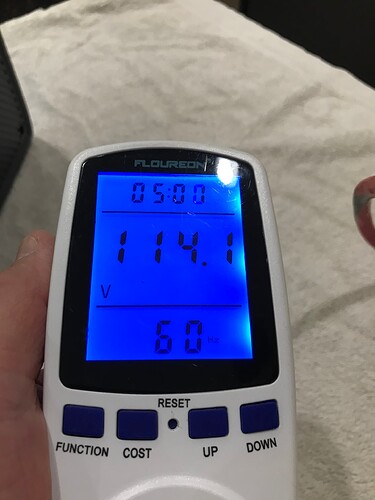



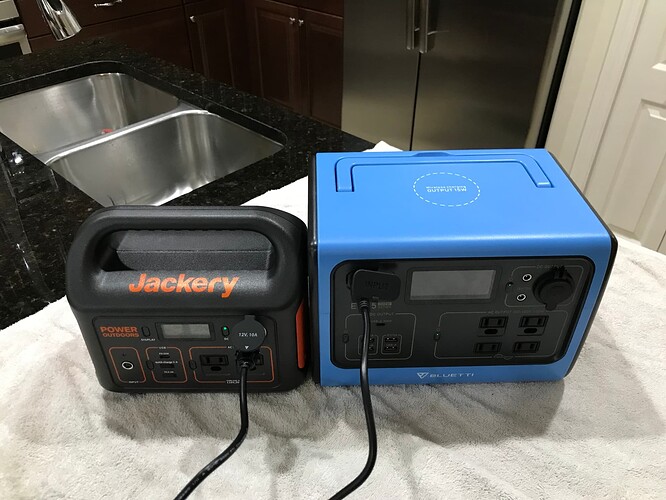
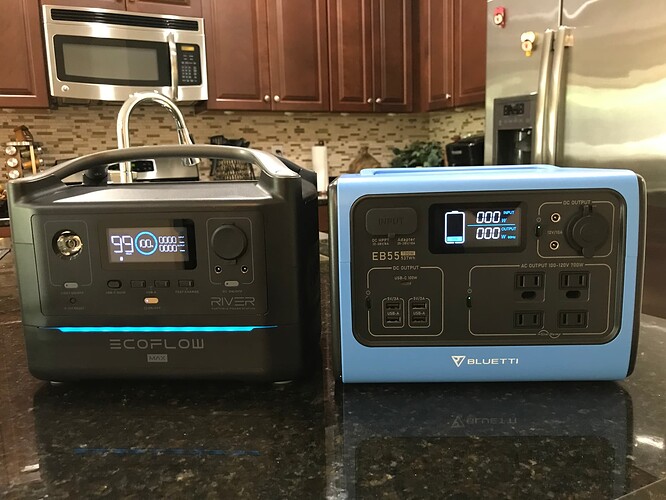
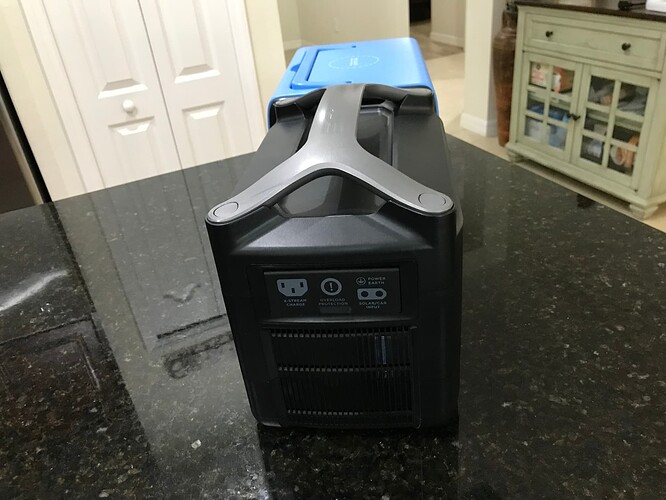


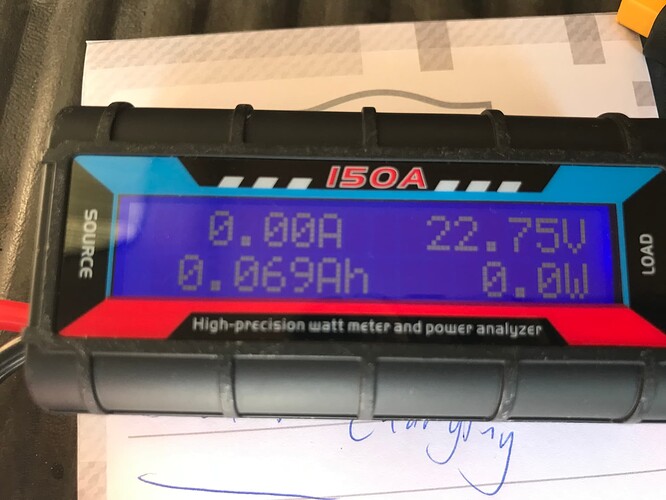
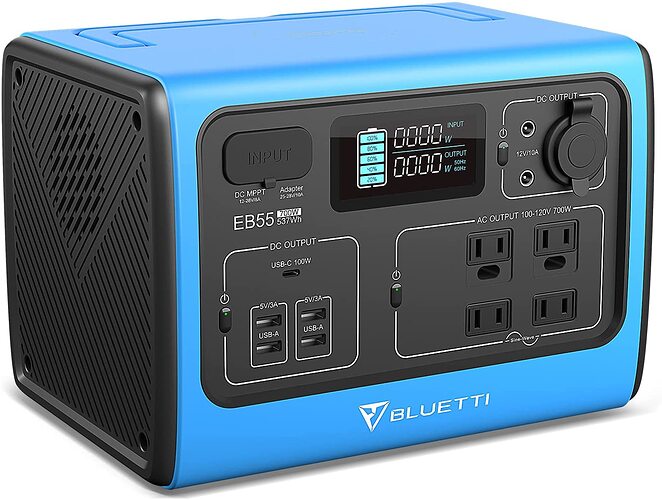
 I’ve got the EB70 unit and was interested to see if the EB55 was a potential replacement or had enough features to add to the stable. If Bluetti had improved the display with battery percent and provided a real on/off button, I would have bought it in a heartbeat - as is, I probably will hold out for a larger power station (the AC200Max, for instance).
I’ve got the EB70 unit and was interested to see if the EB55 was a potential replacement or had enough features to add to the stable. If Bluetti had improved the display with battery percent and provided a real on/off button, I would have bought it in a heartbeat - as is, I probably will hold out for a larger power station (the AC200Max, for instance).